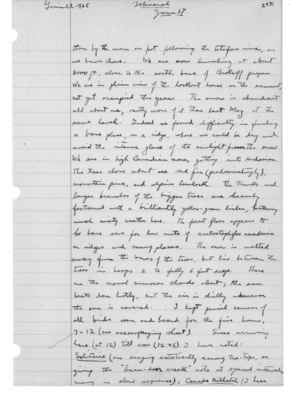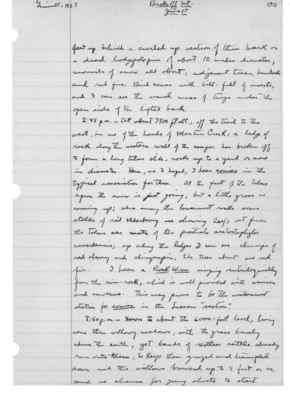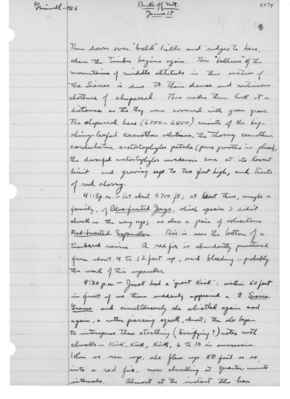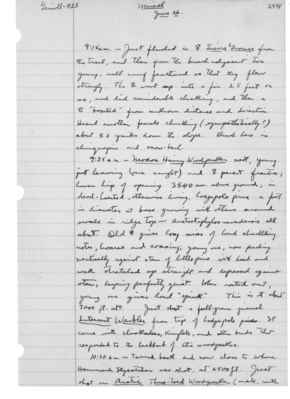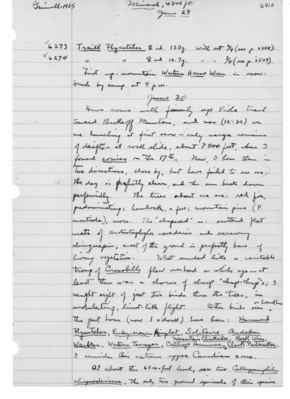Pages That Mention arctostaphylos nevadensis
1925: Joseph Grinnell's field notes
S2 Page 15
Collector: Grinnell - 1925 Location: Lassen Section (Mineral) Date: June 17, 1925 Page Number: 2471
then by the man on foot following the telephone wire, as we have done. We are now leveling at about 8000 ft., close to the south base of Brokeoff proper. We are in plain view of the lookout house on the summit, not yet occupied this year. The snow is abundant all about us, vastly more of it than last May at the same level. Indeed we found difficulty in finding a bare place, or a ridge, where we could be dry and avoid the intense glare of the sunlight from the snow. We are in high Canadian zone, getting into Hudsonian. The trees close about are red fir (predominantly), mountain pine, and alpine hemlock. The trunks and larger branches of the bigger trees are heavily festooned with a brilliantly yellow-green lichen, betokening much misty weather here. The forest floor appears to be bare save for low mats of arctostaphylos nevadensis on ridges and sunny places. The snow is melted away from the bases of the trees, but lies between the trees in heaps 2 to fully 6 feet deep. There are the usual summer clouds about; the sun beats down hotly, but the air is chilly whenever the sun is covered. I kept pencil census of all birds seen and heard for the five hours, 7-12 (see accompanying sheet). Some arriving here (at 12) till now (12:45) I have noted: Solitaire (one singing extatically among tree-tops, or giving the "barn-door creak" note at spaced intervals, many in slow sequence); Canada Nuthatch (I hear
S2 Page 18
Collector: Grinnell - 1925 Location: Lassen Section (Brokeoff Mt.) Date: June 17, 1925 Page Number: 2471
feet up behind a curled up section of thin bark on a dead lodgepole pine of about 10 inches diameter; mounds of snow all about; adjacent trees, hemlocks and red firs. Bird comes with bill-full of insects, and I can see the usual mass of twigs under the open side of the lifted park. 2:45 p.m. - At about 7500 ft. alt.; off the trail to the west, in one of the heads of Martin Creek; a ledge of rock along the western wall of the canyon has broken off to form a long talus slide, rocks up to a yard or more in diameter. Here, as I hoped, I hear conies in the typical association for them. At the fast of the Talus apron the snow is just going, but a little grass is coming up; also among the lowermost rocks some stalks of red elderberry are showing leaf; out from the Talus are mats of the prostrate arctostaphylos nevadensis; up along the ledges I can see clumps of red cherry and chinquapin; the trees about are red fir. I hear a Rock Wren singing ventriloquially from the rim-rock, which is well provided with crevices and caverns. This may prove to be the westernmost station for conies in the Lassen "section." 3:50 p.m. - Down to about 600-foot level, having come thru willowy meadows, with the grass barely above the earth, yet bands of restless cattle already run onto them, to keep them grazed and trampled down and the willows browsed up to 5 feet or so, and no chance for young shoots to start.
S2 Page 19
Collector: Grinnell - 1925 Location: Lassen Section (Brokeoff Mt.) Date: June 17, 1925 Page Number: 2474
Then down over "bald" hills and ridges to here, where the Timber begins again. This "baldness" of the mountains of middle altitude in this section of the Sierras is due to their dense and continuous clothure of chaparral. This makes them look at a distance as tho they were covered with green grass. The chaparral here (6000-6500) consists of the big shiny-leafed ceanothus velutinus, the thorny ceanothus condulatus, arctostaphylos patula (pure growths in places), the dwarfed arctostaphylos nevadensis here at its lowest limit and growing up to two feet high, and tracts of red cherry. 4:15 p.m. - At about 6700 ft.; at least there, maybe a family, of Blue-fronted Jays, which species I didn't check on the way up; as also a pair of solicitous Red-breasted Sapsuckers. This is near the bottom of a timbered ravine. A red fir is abundantly punctured from about 4 to 12 feet up, and bleeding - probably the work of this sapsucker. 4:30 p.m. - Just had a "great kick": within 50 feet in front of us there suddenly appeared a female Sierra Grouse and simultaneously she whistled again and again, a rather piercing squall, almost; then she began to intersperse these startling (terrifying?) notes with clucks - kirk, kirk, kirk, 6 to 10 in succession. When we ran up, she flew up 80 feet or so into a red fir, now clucking at quarter-minute intervals. Almost at the instant the hen
S2 Page 44
Collector: Grinnell - 1925 Location: Mineral Date: June 26 Page Number: 2498
9:14 a.m. - Just flushed a [female symbol] Sierra Grouse from the trail, and then from the brush adjacent two young, well enuf feathered so that they flew strongly. The [female symbol] went up into a fir 25 feet or so, and did considerable clucking, and then a [male symbol] "boonted" from unknown distance and direction. Heard another female clucking (sympathetically?) about 50 yards down the slope. Brush here is chinquapin and snow-bush.
9:35 a.m. - Modoc Hairy Woodpecker nest, young just leaving (one caught) and [female symbol] parent frantic; lower lip of opening 3540 mm. above ground; in dead-hearted, otherwise living, lodgepole pine a foot in diameter at base growing with others around swale in ridge top - Arctostaphylos nevadensis all about. Old [female symbol] gives long series of loud chuckling notes, hoarse and coaxing; young one, now perching vertically against stem of little pine with head and neck stretched up straight and depressed against stem, keeping perfectly quiet. When routed out, young one gives loud "spink." This is at about 7000 ft. alt. Just shot a full-grown juvenal Lutescent Warbler from tip of lodgepole pines. It came with chickadees, Kinglets, and other birds that responded to the hubbub of the woodpeckers.
10:30 a.m. - Turned back and now close to where Hammond Flycatcher was shot, at 6500 ft. Just shot an Arctic Three-toed Woodpecker (male, with
S2 Page 57
Collector: Grinnell - 1925 Location: Mineral, 4800 ft. Date: June 29 Page Number: 2510
6273 Traill Flycatcher [female symbol] ad. 13.0 g. with set 3/4 (see p. 2508). 6274 Traill] [Flycatcher] [female symbol] ad. 12.7 g. [with] [set] 3/4 (see p. 2509).
First up - mountain Western House Wren in snow brush by camp at 4 p.m.
June 30 Have come with family up Viola trail towards Brokeoff Mountain, and now (12:30) we are lunching at first snow - only meagre remains of drifts - at rock slide, about 7500 feet, where I found conies on the 17th. Now, I hear them in two directions, close by, but have failed to see one. The day is perfectly clear, and the sun beats down perfervidly. The trees about me are: red fir, predominating; hemlock, a few; mountain pine (P. monticola), more. The "chaparral" is: scattered flat mats of arctostaphylos nevadensis and scrawny chinquapin; most of the ground is perfectly bare of living vegetation. What sounded like a veritable troup of Crossbills flew overhead a while ago - at least there was a chorus of sharp "chup-chup's"; I caught sight of just two birds thru the trees, in undulating, linnet-like flight. Other birds seen ^or heard here the past hour (now 1 o'clock) have been: Hammond Flycatcher, Ruby-crown Kinglet, Solitaire, Audubon Warbler, Western Tanager, Calliope Hummer,^ Mountain Chickadee, Rock Wren, Clark Nutcracker. I consider this extreme upper Canadian zone.
At about 6500-foot level, saw two Callospermophilus chrysodeirus, the only two ground squirrels of this species
